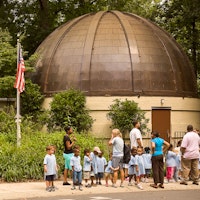How Hurricanes Build and Five Tips to Keep Your Family Safe
Discovery Place Nature
As a native North Carolinian, I’m no stranger to hurricanes. Whether it was Bertha, Fran, Floyd or now Florence, North Carolina is the fourth most hurricane prone state in the country. The only states that see more hurricanes strikes are Florida, Texas and Louisiana.
Growing up in eastern North Carolina, I saw first-hand the destruction that a hurricane can cause. A large oak tree fell on my house during Floyd and we lost power for a week during Fran. I have since been humbled and amazed by the power of these storms.
So what exactly is a hurricane? And how do they get so strong?
Simply put, a hurricane is a tropical cyclone; a massive area of rotating low pressure. Tropical cyclones occur in oceans all around the world. In the Atlantic and northeast Pacific, cyclones are referred to as hurricanes, and in the northwest Pacific they are referred to as typhoons. These storms form almost exclusively in tropical regions, hence the name tropical cyclone. These storms spin counterclockwise in the Northern Hemisphere and clockwise in the Southern Hemisphere, due to the Coriolis Effect, the inertial force created by the spin of Earth on its axis deflecting air masses at the equator.
What causes these storms to form?
These storms are formed by the rapid evaporation of warm ocean waters. As this air rises, it cools and condenses, forming clouds, rain and thunderstorms. This rising air leaves less air at the surface, causing a lower pressure. Cooler air then pushes its way in at the surface to replace this rising air. This new air then heats up and rises again, creating more clouds, rain and wind. Over time, this system of moving air continues to grow larger and larger, and spin faster and faster. It’s essentially a positive feedback loop very much like the engine of your car. The more gas you give it, the faster it goes.

How do hurricanes travel such far distances?
Earth’s atmosphere is like a highway system. At the equator there are trade winds blowing east to west and steering systems in that direction. As warm air at the equator rises it moves toward the poles where it cools and sinks, creating high pressure. This combination of rising and sinking air creates high and low pressure systems across the globe. It is this pressure gradient, or moving air, that steers hurricanes.
As you prepare for Florence and other hurricanes in the future, here are some helpful tips to keep you and your family safe during inclement weather.
- The deadliest threat from a hurricane is water, not wind. From 1963 to 2012, seven of eight hurricane fatalities were cause by water from storm surge or flooding from rainfall. Never attempt to drive across flooded streets.
- If you live in hurricane or flood prone areas, plan to evacuate. Make sure to take pictures of your home and property for insurance claims.
- Hurricanes are hundreds of miles in diameter and effects can be felt well outside of the center and very far inland. Prepare a hurricane kit by stocking up on emergency supplies such as water, food, medications, batteries, flashlights, gasoline and any important documents.
- The power may be out for a while, so if you have one, prepare your generator in advance and get cash from the ATM.
- Be prepared. Constantly check local weather updates and newscasts, as severe weather like tornadoes is often associated with hurricanes.
Need some inside activities activities to keep kids entertained during power outages and help educate them on what is going on outside? Check out our blog on Discovery Place Kids-Rockingham for three hurricane-day activities.

